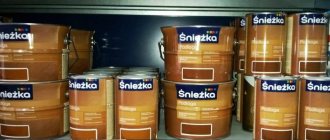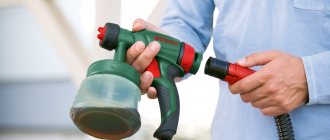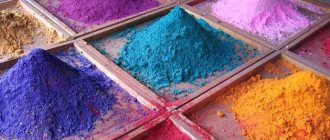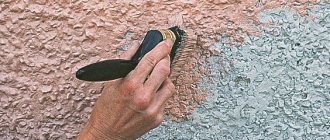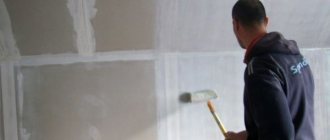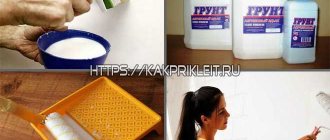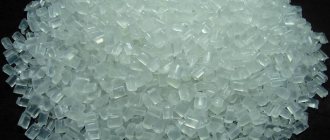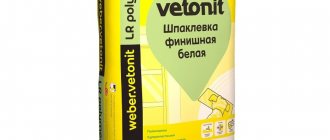What is alkyd paint
Alkyd paint is one of the universal paint and varnish coatings based on a solvent of organic origin.
Alkyd paint is one of the universal paint and varnish coatings based on a solvent of organic origin.
Most often, purified kerosene is used as a solvent. In addition, the alkyd paint coating necessarily contains alkyd varnish, various fillers, coloring pigments and other components.
Classification
Depending on the type, alkyd enamel may have different properties and features. Each type is designated by a separate code of letters and numbers - it helps to quickly determine which category a particular product belongs to.
Let's consider one of the popular paints - alkyd enamel PF-120. This is a matte white paint based on pentaphthalic varnish. Number 1 indicates that the product is suitable for outdoor use. 20 – catalog number.
In addition to this marking, there are other numbers. Let's look at what they mean:
- 0 – alkyd primer enamel;
- 2 – coatings for interior work;
- 3 – conservation paint;
- 4 – paintwork materials, resistant to moisture and water;
- 5 – special materials with special properties;
- 6 – enamels that can withstand the effects of oils and gasoline;
- 7 – paint that can withstand aggressive chemical attack;
- 8 – heat-resistant paints and varnishes;
- 9 – electrically conductive and insulating coatings.
Composition of alkyd paints
The composition of the product will depend on the specific purposes for which it will be used. If the paint is intended for wood, then it contains antiseptics. In the case of using material for a metal base, anti-corrosion components are added to the paint.
Film formers
The basis of alkyd paint are film formers. The final characteristics of the material will depend on them. Most often, glypthal or pentaphthalic film formers are used for such paint and varnish coatings. The main difference between these components is which polyhydric alcohol will be used. For glyphthalic resins, glycerin is used, and for pentaphthalic resins, pentaerythritol is used.
Solvents and thinners
Depending on the specific fat content of the film former, one or another solvent will be used. For alkyds with a high fat content, it is customary to use aliphatic solvents. For less fatty ones, aromatic solvents are suitable. For components with medium fat content, solvent mixtures are used. Alcohols, ketones or esters can also be added.
Thinners are not so expensive and are used in situations where it is necessary to slightly change the properties of the finished material and adjust them to certain operating conditions.
Most often, kerosene or solvent is used as a diluent. Each manufacturer indicates which thinner is best to add in containers with alkyd enamel.
Pigments
To ensure that the paint coating is not transparent and has a specific color, special pigments are used during production.
These are colored powders that color the base a certain color. Inorganic or organic pigments, artificial or natural origin, can be used. Pigments affect not only the decorative properties of the material, but also the performance characteristics. They can affect the protective function of the paintwork and other important properties of the material.
Fillers
Fillers are usually used to improve the technological characteristics of alkyd enamel.
Due to this, it is possible to increase the viscosity, opacity, corrosion, as well as atmospheric resistance and other parameters of the material. In some situations, fillers may have either weak coloring or matting properties. In most cases, limestone or marble chips are used as fillers. Various silicates are used less frequently. In order to increase wear resistance, granite or quartz is added to the paint. To obtain electrical insulating properties or heat-resistant characteristics, mica is suitable. Recently, many manufacturers give preference to fillers of natural origin.
Supplements
A variety of additives can be added to alkyd paint. In order to accelerate oxidative processes, driers, which are soluble organometallic compounds, are used. To make alkyd enamel more elastic and tolerate temperature changes well, the composition contains plasticizers. Such additives are subject to certain requirements - neutrality, absence of odor and color, compatibility, etc.
Stabilizing and special anticoagulation additives also play a huge role. With their help, the paint can be evenly distributed over the surface being treated.
Some manufacturers may additionally use special enhancers of the anti-corrosion characteristics of the material. Most often it is tannic acid. If alkyd paint is used for exterior work, then a substance is added to it that absorbs ultraviolet radiation.
Pros and cons of alkyd compounds
Their undoubted advantage is increased strength and durability. The film formed during the drying process of paint has great elasticity, so it cracks less than oil film.
- The ability to withstand even severe temperature changes allows the use of alkyd enamels for outdoor use. They are not afraid of sunlight, so they do not turn yellow and fade more slowly in the sun. The chemical resistance of such compositions is also excellent - they can be washed even with fairly aggressive detergents.
- Significant advantages of enamels are minimal consumption and high drying speed. If oil paints take 2 days to harden, alkyd enamel dries faster - no more than 24 hours. When introducing special hardeners, this requires even less time - up to 6 hours. Its service life is 15 years, and when used outdoors 6 years.
- But enamels have a significant drawback - until they dry and form a film, they emit a pungent odor. Therefore, you should work with them in ventilated areas wearing a respirator. The hardened film no longer poses a health hazard - the toxic substances erode from it.
Classification of alkyd enamels
There is a fairly large selection of alkyd paint and varnish coatings on sale. We will consider the most popular and in demand options today.
Enamel GF 230
This product is made on a glyphthalic base.
Most often, this enamel is used for interior work. You cannot use paint for the floor, because it cannot protect the base from mechanical stress. Before use, the material must be diluted with a solvent recommended by the manufacturer. Paint is available in different colors and shades, so choosing the right option will not be difficult. The material can be applied using a brush, spray gun or roller. Drying time for the coating will depend on the conditions present during the repair. On average, it takes a day to dry. The disadvantage of GF 230 enamel is that it has a very pungent and unpleasant odor.
Paint PF 133
The product has a pentaphthalic base. Used for processing metal structures that are pre-coated with a layer of primer. The paint must be applied in several layers. Between each layer there is a break of several hours to allow the surface to dry. The material is available in several colors. Many people like the fact that the paint is very bright. In temperate climates it can be used for no more than 6 years.
Enamel PF 115
The products are used for processing metal, wood and other surfaces. The material must be applied in 2 layers. There are 24 enamel colors on sale. Paint can be applied either manually or using special construction equipment. It will take at least 8 hours to dry. The coating has a beautiful glossy shine and rich color.
PF 223
This alkyd enamel is used for treating wooden and metal surfaces. Manufacturers offer 17 colors. The material tolerates high temperatures very well. It is necessary to dilute only with the means specified by the manufacturer on the container. On average, it takes 30 hours for the coating to dry completely. During work, be sure to use a respirator, because alkyd paint has too strong a smell.
Enamel PF 253
The material is most often used to treat wooden floors. Enamel can be applied to the surface only after it has been covered with a layer of primer. To obtain maximum processing quality, it is necessary to apply two layers. To thin the paint, you can use gasoline or turpentine. A huge advantage of the product is that it takes a minimal amount of time to dry. After the coating is completely dry, it acquires an attractive glossy shine.
paints and varnishes
0 votes
+
Vote for!
—
Vote against!
There are a great variety of alkyd enamels. This paint coating is distinguished by its versatility, abrasion resistance, and bright colors. It can be used for both interior and exterior work, and due to the fact that alkyd enamel paint can be glossy, matte, or semi-matte, its scope of application is almost limitless.
Content:
- Composition of alkyd enamels and their properties
- Features of alkyd enamels
- Classification of alkyd enamels
- Alkyd enamel GF-230
- Alkyd enamel PF-133
- Alkyd enamel PF-115
- Alkyd enamel PF-223
- Alkyd enamel PF-253
- Alkyd enamel PF-126
- Matte enamels
- Aerosol enamels
- Manufacturers of alkyd enamels
Composition of alkyd enamels and their properties
Alkyd enamels are made on the basis of alkyd varnish and various solvents with filler. In addition, they contain coloring pigments that give the coating a certain color. Sometimes the manufacturer may include various additives in the combination, for example, antiseptics that protect the painted surface from mold and fungal infections. The main solvent for alkyd enamels is white spirit. By the way, this is what you should use if the paint has thickened. And the fillers are usually sand, granite or marble chips and other materials that have the same properties. Fillers for paint and varnish coatings should not be confused with traditional sand and crumbs - their grinding is much finer and the structure of these materials is more similar to flour.
The most important component of alkyd enamels is alkyd varnish, which comes in two types: pentaphthalic and glypthal. Most often, in the production of paints, pentaphthalic varnish is used, which is a thick solution of resin in a solvent with the addition of vegetable oils, rosin and glycerin. The finished varnish is later mixed with a solvent to form an alkyd enamel.
Features of alkyd enamels
The features of alkyd enamels include their high elasticity and durability. Such coatings dry quickly enough, which allows them to be used indoors without much concern. In addition, such paints do not turn yellow when dry, do not lose their color, or shrink.
They are also suitable for outdoor work, since they have high weather resistance - snow, rain, and temperature changes are not a problem for alkyd enamels.
This type of paint coating perfectly protects various metal surfaces (doors, windows, radiators, furniture, etc.) from corrosion; it is also able to withstand wet cleaning with conventional detergents and can be used in bathrooms, saunas and swimming pools.
Classification of alkyd enamels
Depending on the classification, alkyd enamels have different properties, methods and areas of application. Each brand has its own alphanumeric code, which allows you to determine whether the enamel belongs to a particular category. For example, alkyd enamel PF-120 matte white is deciphered as follows: PF - pentaphthalic (these letters indicate the substance that is used in the paint as a base); the number 1 means that the enamel can be used for outdoor work, and the number 20 is the catalog number.
In addition to the unit, other numbers can be found on alkyd enamels: the number “ 0 ” indicates alkyd primer enamel, that is, a coating intended for priming surfaces;
2 — enamel for indoor use (heated and unheated);
3 — conservation paints, that is, paints and varnishes that are intended for temporary sealing of any equipment;
4 - waterproof paints;
5 — special paints with special characteristics (rodent repellent, glow in the dark, etc.);
6 — oil and petrol resistant enamels;
7 — paints that can withstand chemical attack;
8 — heat-resistant paints;
9 — electrically conductive and electrically insulating paints.
Alkyd enamel GF-230
In this case, GF is glyphthalic. This paint is intended only for interior painting of ceilings and walls. It cannot be used for painting floors, since it does not withstand physical influences well. Before you start using the enamel, it must be diluted to the desired consistency with white spirit or turpentine. There are quite a few shades of glyphthalic enamel GF-230, ranging from light cream to dark colors. It can be applied with a brush, roller or spray. It dries in about a day and has a distinct varnish smell.
Alkyd enamel PF-133
It is used for painting metal surfaces or surfaces that have been pre-primed. It is usually applied in two layers, since its covering ability is not too high (ranging from 20 to 120 g/m2). Dries in 2 hours and comes in 15 subtle shades. In temperate climates, PF-133 enamel retains its protective properties for 5-6 years, and it does not crack or deform.
Alkyd enamel PF-115
Designed for exterior painting of metal, wood and other surfaces. This enamel needs to be applied in two layers, since its covering ability is not too high (30-120 g/m2). Available in 24 shades, applied by spray or brush, drying from 8 to 24 hours. Alkyd glossy enamel PF-115 has a pleasant shine, giving the surface a bright, rich color.
Alkyd enamel PF-223
Its scope of application is interior finishing of wooden and metal surfaces. This alkyd enamel is perfect for radiators - it has 17 shades to suit every taste, hides old paint well and withstands high temperatures well. Diluted to the desired consistency with solvent, gasoline or xylene. Drying time 30-36 hours. The smell is specific, pungent.
Alkyd enamel PF-253
Scope of application: pre-primed plank floors. Apply in two layers using a wide or medium brush. Diluted with turpentine or gasoline. Dries quickly (drying time depends on the thickness of the layer and the temperature inside the room). After drying, the surface acquires an even, flawless gloss.
Alkyd enamel PF-126
This type of enamel is sold complete with NF-1 filler, which accelerates hardening. Apply the paint with a brush or roller in two thick layers with intermediate drying of 30-40 minutes. Before application, the surface is primed with enamel diluted with white spirit.
Matte enamels
Sometimes matte alkyd enamel may be required to paint surfaces. As a rule, such paint is intended for both exterior and interior use. It is durable, resistant to water, detergents, and oils. Able to withstand temperature fluctuations from -50 to +60o C. It is economically consumed, as it has a high covering ability (90-180 g/m2). Diluted with solvent or white spirit.
Aerosol enamels
Aerosol alkyd enamel is easy to use, since there is no need for brushes and rollers, it fits well on any surface and dries very quickly (3-5 hours). It is able to penetrate into any cracks, so it is recommended to paint hard-to-reach places, and the scope of application of such paint is very wide: from garden furniture to stucco on the ceiling.
In addition to the above, there are other types of alkyd enamels, the purpose of which also applies to painting walls, ceilings, floors and other surfaces both outside and inside the house.
Manufacturers of alkyd enamels
On store shelves you can find a huge assortment of alkyd enamels, both Russian and foreign. How do the former differ from the latter?
Firstly, the majority of Russian manufacturers do not rely on packaging: paints are “packed” either in metal or plastic cans. Imported enamels, as a rule, have bright, attractive packaging that distinguishes “overseas” products from their Russian neighbors.
Secondly, a price of 200-300 rubles per liter jar is clearly not suitable for high-quality alkyd enamel, and these are the price tags that are sometimes found on shelves with Russian products. Imported analogues are many times more expensive.
Thirdly, expensive imported enamels contain only the highest quality components that have passed all kinds of tests. It is due to such “ingredients” that enamels produced abroad have virtually no odor, dry quickly, have a huge number of shades and are well distributed over the surface, leaving no streaks or smudges. For example, Tikkuril alkyd enamel "Miranol" is ideal for painting furniture, window frames, doors and even children's toys - its level of safety is so high. It is not yet possible to say something similar about Russian enamels, although our manufacturers have recently been trying to pay as much attention as possible to the environmental friendliness of their products.
When buying alkyd enamel, you should pay attention to its shelf life - the fresher the paint, the better and smoother the coating will be. Well, the most important thing is that you don’t need to chase cheap or expensive - choose the “golden mean” - you definitely won’t go wrong!
Advantages and disadvantages
Alkyd paint is considered a special type of finishing materials. Has a huge number of advantages. The main ones include the following:
- High resistance, elasticity and durability.
- Over time, the coating does not crack or begin to peel off.
- Can be used for both interior and exterior work.
- Tolerates sudden changes in temperature very well.
- Additionally protects treated surfaces from the effects of negative factors.
- Can be used on a wide variety of substrates.
- Has a high adhesion rate.
- Dries very quickly.
- Alkyd enamel is very easy to apply.
- Some types of paint have excellent antiseptic as well as anti-corrosion functions.
- Has minimal consumption.
- Has an affordable price.
At the same time, there are some disadvantages that are worth remembering when choosing a material for processing a particular surface. The main disadvantages include the following:
- Too strong odor and high toxicity.
- Low vapor permeability.
- May ignite easily.
- Does not tolerate exposure to alkalis very well.
If you use the material correctly, these shortcomings will not cause any inconvenience.
Peculiarities
Alkyd enamel appeared relatively recently and in a short period of time was able to gain popularity, displacing other types of paint and varnish coatings.
This product is distinguished by its versatility, due to which it is actively used not only for interior work (finishing floors and walls), but also for exterior repairs.
The defining difference between alkyd enamel and acrylic enamel is resistance to mechanical damage, as well as the ability to perfectly resist abrasion. Even after many years, the surface finished with alkyd enamel continues to retain its attractive appearance.
Thus, among the main features of this type of enamel one can highlight its impressive elasticity and durability.
The material requires a minimum amount of time to dry, so it can be used in any room.
Another advantage of this type of paint coating is that it does not turn yellow over time and does not lose its original color.
Where is it used?
Due to their excellent characteristics and high-quality composition, alkyd paints can be used to cover a wide variety of substrates. Most often, paint and varnish coating is used to treat roofs, pipelines, benches, metal structures, and various products made of galvanized metal.
Most paints contain special corrosion inhibitors.
Also on sale are options that are suitable for processing wooden bases. Antiseptics are added to such enamels to further protect the wood from negative factors. Universal enamels are suitable for processing concrete, brick or cement.
Consumption of coloring composition
The consumption of the dye depends on the preparation of the surface for painting, as well as the number of layers. The best option is 2 layers, since 1 is not bright enough, and it makes no sense to do more than 2.
Paint consumption – from 100 to 180 g/m². On average, it turns out that 1 kg of the composition is enough to paint an area of 15 m². When calculating, the location of the surface is taken into account: the horizontal surface requires 7% less material than the vertical surface (since it drains from the latter).
In addition, a larger amount of composition will be needed on a wooden base, since wood tends to absorb it. The same applies to concrete and plastered surfaces. Metal bases must be cleaned of dirt and traces of corrosion in order to save paint composition.
To save the mixture, you can dilute it with solvents, but not much. Also, to reduce consumption, use a silicone-based roller. An economical tool for processing is a spray gun.
Enamel consumption is calculated per 1 square meter.
Consumption
To calculate the approximate consumption of alkyd enamel, you need to pay attention to the degree of viscosity of the material. The thicker the paint, the more it will have to be used, so you will need to dilute it with a solvent first. Also, the consumption will be influenced by the number of layers that are applied to the surface and the characteristics of the base itself. More alkyd paint will be required for metal structures. Each layer must dry well. This will take at least a day.
Scope of application
Due to the wide range of types and universal properties, alkyd enamels are widely used in repairs and construction for painting almost any material. Such coatings can be used for interior and exterior repair work. Alkyd enamels are most often used for painting structures made of metal, wood and concrete.
Alkyd-urethane paint for metal structures reliably protects the surface from the influence of negative environmental factors and prevents the formation of rust.
It can be used for painting industrial structures and household objects, for example, heating radiators.
A special alkyd enamel is produced for machine parts. This paint is made on the basis of glyphthalic resins. Alkyd enamel can also be used to coat the body of a vehicle. The automotive mixture is applied in three layers, which increases its complete drying time.
The resulting coating is highly durable and resistant to cracking.
Paint based on pentaphthalic resins is ideal for painting floors and walls, as it has excellent resistance to abrasion and mechanical stress. This composition is also widely used for processing metal structures for various purposes.
Manufacturers
Today, many manufacturers are engaged in the production of paint and varnish coatings and offer truly high-quality products. When purchasing, you should pay attention not only to the composition, but also to the company that produced the alkyd enamel. Preference should be given to more popular manufacturers who have long established themselves in the construction market. Let's look at the most popular companies today.
- "Lakra." The company has been producing alkyd enamels for more than 20 years. Products are supplied not only to domestic but also to foreign markets. The company offers enamels for different types of work.
- "Tex." The company has been operating for more than 15 years and produces high-quality paint and varnish coatings, which is confirmed by the presence of international certificates. The manufacturer offers universal alkyd paints that have a long service life and additionally protect the base from damage.
- "Tikkurila". The company has been operating for 150 years and during this time has developed a huge number of products aimed at protecting foundations. The manufacturer offers a wide selection of alkyd enamels for different purposes and substrates.
- Dulux. Alkyd paints from this manufacturer can be used for a variety of purposes. The company has earned popularity and recognition in 26 countries around the world.
- "Kraffa" Production of products is very strictly controlled. Alkyd enamels are produced using modern equipment and only from the best raw materials. A huge advantage of the product is that it is completely safe for human health.
Composition, main properties
Alkyd enamel is a product of the synthesis of alkyd varnishes and organic solvents with the addition of special fillers. But along with this, the composition also includes other additives - these are pigments, as well as antiseptic materials, the function of which is to resist the development of fungal spores and mold. Some paints also contain anti-corrosion additives - these compounds are used for painting metal surfaces.
Most manufacturers use traditional white spirit as an organic solvent. It is also used in case of paint thickening.
Often the composition includes a filler based on sand, granite or marble chips. But you don’t need to think that this is ordinary sand or crumbs - fillers for paints are ground into a much smaller fraction. The texture is more like flour.
The main element of any alkyd paint is alkyd varnish. Two types of varnishes are produced - pentaphthalic and glyphthalic.
The first is used in the manufacture of paints and varnishes. Pentaphthalic varnish is a combination of thick alkyd resin, organic solvent, as well as vegetable oils, rosin, and glycerin. Then this mass is combined with solvents - the result is alkyd-type enamel.
One of the differences between pentaphthalic varnish is its rapid hardening speed during cold drying. After complete drying, a moisture-resistant coating is formed on the surface. At the same time, the degree of fat content and the type of modifier in the two types of varnishes are the same.
Pentaphthalic paint is more common in everyday life and in industrial production - these paints and varnishes are widely used for painting floors due to their high resistance to wear and abrasion. They are also used to paint metal surfaces, public transport, trailers, and railway cars.
Such enamel can retain its protective characteristics for up to 6 years if it was used for outdoor work. The coating lasts indoors for 15 years.
Glyphthalic enamel also has a lot of advantages - it dries faster compared to paint based on pentaphthalic varnish. A day is enough for complete drying. But now quick-drying alkyd-based materials are also being produced - complete hardening requires no more than 6 hours, depending on conditions.
Alkyd resin, depending on the level of fat content, is divided into drying and non-drying. An independent film former for alkyd paint is a drying alkyd, which is formed as a result of hot and cold drying. This alkyd is actively involved in other resin compositions.
The non-drying resin is applicable in urea resin products with cellulose nitrates. This connection increases adhesion to any surface and makes the paint more elastic.
Rating of alkyd paints 2019
Alkyd enamels were thoroughly tested and, based on the results obtained, it was possible to compile a list of the best manufacturers.
| Category | Name | Price |
| The best alkyd paint for wood | TEX enamel for wood and metal PROFI, 2.7 l | 949 rub. |
| Tikkurila Miranol, 2.7 l | 2200 rub. | |
| Dulux Domus, 2.5 l | 1800 rub. | |
| The best alkyd paint for exterior use | Tikkurila Unica Ulkokalustemaali, 2.7 l | 2500 rub. |
| Capadur UniversalLasur, 2.5 l | 2690 rub. | |
| Alpa Element LA-007, 1.8 l | 490 rub. | |
| The best alkyd paint for interior work (odorless) | Kraffa Classic Enamel PF-115, 2.7 l | 639 rub. |
| PF 115 Triol, 2.2 l | 2500 rub. | |
| Tikkurila Empire, 2.7 l | 1500 rub. | |
| The best alkyd paint for metal | Dulux Master, 2.5 l | 1800 rub. |
| Heat-resistant enamel Certa, 0.8 kg | 400 rub. | |
| Alpina Heizkorper, 2.5 l | 2460 rub. | |
| The best alkyd paint for cars | Colomix, 1 l | from 800 rub. |
| Mobihel, 1 l | 1020 rub. | |
| Vika-60, 0.8 kg | from 570 rub. | |
| The best alkyd paint for floors | Lakra PF-266, 2.2 kg | 460 rub. |
| Enamel PF-266 Prestige, 2.8 kg | 380 rub. | |
| Betolux Aqua Tikkurila, 0.9 l | 960 rub. |
Alkyd enamel has excellent characteristics and is liked by many builders.
With its help, you can make repairs of higher quality and it will last for more than one year. The main thing is to choose the right type of paint and prepare the base for further painting.
Review of manufacturers
Almost every brand produces dozens of types of alkyd paints for wood, metal, plastic, concrete and other surfaces.
Leaders recognized by professionals and who have earned thousands of positive reviews:
- Kudo . The brand produces paints for household and professional use. Including for covering tiles, cars, motorcycles. There are options for finishing the premises inside and outside the building. The most popular are aerosol forms.
- Olimp . There are pure alkyd and alkyd-urethane substances. Used for painting concrete floors, facades, radiators, windows and doors. They have powerful antiseptic and anti-corrosion properties.
- Tikkurila . Popular Finnish paints, deservedly recognized as number 1 on the market. Serve up to 20 years. Safe, easy to use, hundreds of colors.
- Belinka . Specialized paints for wood with a large number of shades.
- Sadolin . Swedish paints for wood and metal. There are colored compositions, as well as enamels, to which colors can be added.
- Alpina . The company produces paints and enamels for household use on various materials.
Paint classification
These paints differ in their qualities and components. On the packaging you can see that they have letter and number markings. From these data, the properties of the solution can be determined. PF, GF means that the main components are, in accordance with the letters, pentaphthalic and glypthal varnish. ML, MS: the first abbreviation means the presence of melamine-alkyd elements, the second - alkyd-styrene solutions.
Properties are determined by the 1st digit:
- 1 - can be used for products used outdoors;
- 2 – indoor use, surfaces can be painted in buildings where there is no heating;
- 3 – temporary covering;
- 4 – has water-repellent characteristics;
- 5 - has a special purpose, example: luminescent effect;
- 6 – exhibits resistance to petroleum products;
- 7 – resistant to aggressive chemical solutions;
- 8 – resistant to high temperatures;
- 9 – resistant to electric current and voltage;
- 0 – used as a primer for surfaces.
Enamels are produced in jars and spray cans.
On the packaging you can see that they have letter and number markings.
Advantages of alkyd paints on wood for exterior use
The advantages of the material include:
- Elasticity. The coating is wear-resistant and does not deform under mechanical loads.
- Resistant to temperature changes and UV radiation.
- Moisture resistance. Painted wood can be washed using non-abrasive products.
- Resistance to chemical reagents.
- Durability. The coating retains its appearance for at least 5 years.
- Drying period – from 4 hours to 24 hours.
- Rich palette of bright colors. Alkyd-based enamels can be glossy or matte.
- Versatile and easy to use - can be applied with a roller, brush or spray gun.
- Low price.
Negative features of the coloring composition include:
- specific smell;
- fire hazard;
- instability of the finished coating to the effects of quicklime and caustic soda;
- negative impact on health.
The surface painted with alkyd paint is resistant to a wide variety of adverse influences.
Required Tools
Protective equipment when working with alkyd paints.
When working with alkyd paints, protective equipment is used: gloves, respirator, goggles.
During the painting process you will need:
- solvent;
- painting tools - brushes, roller or spray gun;
- a primer that matches the brand of paint;
- masking tape;
- sandpaper;
- putty knife;
- roller container.
Features of the material
Alkyd enamel for finishing works
The special property that hammer enamel is characterized by is long service life and elasticity. Alkyd urethane enamel dries very quickly, so it can be used when decorating interiors inside buildings.
I would also like to draw your attention to the fact that hammer effect enamel does not turn yellow over time.
Enamel paints are often used for outdoor work because:
- they are not afraid of precipitation in the form of snow, nor in the form of hail and rain;
- are not affected by low temperatures;
- are not afraid of the sun's rays.
Hammer enamel can protect the surface from corrosive changes, which is why enamel paints are often chosen for treating metal products. But metal is not the only base; specialized enamel for wood also exists.
